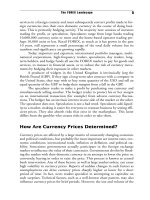The introduction of a system that would improve a manager’s ability to successfully supervise their employees, operating companies has been identified as a solution
Bạn đang xem bản rút gọn của tài liệu. Xem và tải ngay bản đầy đủ của tài liệu tại đây (1014.46 KB, 31 trang )
ABSTRACT
These days' lots of technologies or application software for companies and
businesses in different field. With software they are managing employees with
greater care. This project will investigate how employee performance is currently
being managed and identify a method that would improve employee performance
management and operational management of the company. The introduction of a
system that would improve a manager’s ability to successfully supervise their
employees, operating companies has been identified as a solution.
ACKNOWLEDGEMENT
I would like to acknowledge the following persons for their help and support
throughout the whole project:
My supervisor – for her vital encouragement and support and guiding me in the right
direction.
My Family and Friends - for putting up with me, talking so much about my project
and gave me motivation when I needed and finally specially thanks from my father
and mother that gave this chance to me and study in Greenwich university. I will
always be grateful.
I.
INTRODUCTION
1. Background information:
In today "s current Economic climate organisation within companies sector have to
Ensure That they are managing employees and goods with greater care. This project
will Investigate how employee and goods being managed and performance is being
managed and identify a method that would improve employee, corporate operations
management performance.
2. Project aim and objectives:
The projects aim is to create a key software organisations programme will allow
staff to manage, inventory, billing and equipment. This has broken down six key
Into Objectives, These are:
1. To manage employees, invoices and goods.
2. Investigate a new approach would improve management of employee
performance Improve., Bill, operation of the company
3. Implementation of the system.
4. Perform a successful handover to the stakeholders.
5. Statistical analysis of employee and goods data.
6. Evaluate the performance of the new system. Has it improved the way we manage
our people.
II.
LITERATURE REVIEW
There is a vast amount of staff employed within the companies sector; in large
organisations it can become possible for employee, business performance to become
less of a priority in manager’s daily Business As Usual tasks. This is considered to
be a poor management style which can have a negatively affect employees possibly
resulting in poor performance.
One of the ways for software was the ability of using the database. Two tier
applications have a same scenario with this content. The name of this kind of the
application is a client-server application. In this type of application all business rules
has been saved on the database and database with application saved on the server.
The applications for accessing the database on the server should be used the stored
procedures, and client side can call stored procedures that run on the server side.
Figure 1
This figure shows the two tier structure. "In web application development, three-tier
architecture refers to separating the application process into three specific layers."(1)
The main different between tow tier and three tiers structure is about business rules.
In three tier structure business rules are not saving on the client or the database, in
fact saved in the system between client and server. The main advantage of this
structure concern about business rules of the system. In three tier application system,
server doesn't have direct access to saving part and can changes any parts of system
(business rules) without changing in other parts of system.
The figure 2 shows this structure:
Figure 2
According the above figure, each tier refers to specific duty on the system and those
responsibilities for tiers are:
1) Presentation: the purpose of this tier/part, showing the page for users. It is similar
to user interface.
2) Business rules: this part or tier is kept in different layer of system; C# has a
specific folder (App-code) folder for defining all classes and codes that use in this
part.
3) Database: this is similar to functionality part for business rules and stored
procedures are defined in this part for accessing to the database.
III.
EXISTING SYSTEMS
1. Introduction
This section will analyse existing systems used to assist with employee
management, billing, equipment, customer. Help administrators manage the entire
system, process data quickly and accurately. The system helps users save time
process data that remains very high accuracy.
2. Company Performance System
The first stage of research was to find out what methods for managing staff
performance are currently used within organisations. Appendix C shows a
spreadsheet that is used within the IT department within company, this spreadsheet
displays the employee details and their ratings for each quarter. After another period
of quarterly ratings has been undertaken it becomes the supervisors‟ responsibility
to contribute the ratings for their employees into the spreadsheet.
There are a few benefits to this system, it allows for the data to be easily updated
and an instant analysis of the results can be easily created by clicking the create
scores button. The system is also based in a platform that many users are familiar
with using so it is unlikely that employees will have trouble when using the system.
However there are disadvantages to the system, data is only being held for a
relatively small time period (1 year per spreadsheet) which doesn’t allow a real indepth view of employee’s continuous performances. The ratings themselves don’t
give a great deal of information, for example if an employee has ratings of exceeded
for two continuous quarters the rating will appear as no change where an employee
who had a rating of partial-met for two continuous ratings would also have no
change as there rating. In this situation it could easily be missed that an employee
has been underperforming as there isn’t a clear indication that a situation that needs
to be addressed. After analysing this method of performance management it is clear
that there is potential for better method to be built that would create a simple system
for the users while increasing the management of employee performance. Research
will be conducted into different approaches and technologies needed to build a new
system.
IV.
PROGRAMING METHOD
1. C# and Windows Application
Using Microsoft Visual studio 2008 C#.Net is a programming language that will be
able to provide the functionality that the system would need. There are two different
approaches that can be taken to create the system these are:
A windows application would run as a programme directly on the user‟s machine.
The application can easily be connected to a database through Visual studio allowing
the system to update and modify the data from within the database. A login system
can also be created by using data in the database where the login details will be
stored in the database and the system will validate the information entered by
comparing them with values that are stored in the database. The data that will be
entered into the online forms will be validated by the C# coding that is contained
within the application. The systems will require the .Net (dot net) platform to run
which is included as part of windows operating systems therefore will be able to run
on windows XP and Vista. The systems interface will use the standard form
components such as text boxes, drop down boxes and check boxes. These will be
instantly recognised by the users as they are already commonly used in applications
and online forms allowing users to intuitively know how the use the form
components. The application will suffer the most when it comes to creating a
consistent branding as there is no easy way to duplicate the style allowing it to be
used in all the windows within the application. However the method around this
would be to create a style class and import this into the windows applications.
After comparing these options the decision to create the system as a windows
application programmed in C#.Net using Visual Studio has been taken. The
requirements of the system can be achieved by this using this method, the system
will also benefit from this approach as it will have a greater level of functionality as
a windowed application rather than a web application. As a developer the greater
skills are within C#.Net coding. The next step will be to decide on the type of
database that will be used to hold the systems data
2.SQL server
Four types of databases have been selected as potential databases for the system.
These are Microsoft Access, My SQL, Microsoft SQL Server and Oracle. For the
research a list of the necessary functionality that will be needed in the system and
perform research into each of these areas to see if this functionality can be provided
by the analysed technology. Below is a list of the functions that the system will need
to provide: 1. Connection to Visual Studio 2. Location accessibility of software.
SQL Server is the database package owned by Microsoft, as they also own Visual
Studio they have designed the two packages to work together, for this reason it is the
supported choice of database software for Visual Studio. SQL Server has easy
connectivity to Visual Studio. Data sources are set up and linking to the data from
the SQL server and are used within Visual Studio for the connectivity. Data sources
can be customised allowing data entry into multiple forms to be conducted in a
simple manner. SQL Server is widely used in many organisations due to being easily
obtainable, value for money and high level of support available.
After comparing the database packages Microsoft Access will be used in the initial
stages of the system. This will form the first prototype for the system allowing the
identification of any errors in the database design or any aspects that may have been
missed out in the system. Microsoft SQL Server is the chosen choice for the full
implementation of the system, although Oracle compares well with SQL Server it
loses out on its ability to connect to Visual Studio not being as strong as SQL Server.
ANALYZE THE FUNCTIONS OF THE SYSTEM
1. Admin functions
- Secured with logging functions into system
V.
-
Function of the right to an administrator, manager and staff
Information search functions: customers, employees, equipment, suppliers
Information management: customers, employees, equipment, suppliers, stock, bill
with functions such as add, edit, delete
Management systems such as invoice management, file
In the bill, the output report
Personal Information Management: users have the right to change passwords
2. User functions
- If sign in with the right technical staff, no tab manager, print invoices, and not to
-
search the literature.
If the log by right salespeople, users do not have administrative rights on employees.
PROGRAM INTERFACE
1. Login interface
VI.
This is the first interface when a user wants to log into the system for website
administrators. Users need to enter username and password, login and select their
rights: admin, employee and ISO, then users select "Login". When a user enters the
wrong information, the system will automatically give an error message and ask the
user to enter the correct information. If users do not have an account, you can click
"Register" to register for an account. Interface login with administrator privileges.
When a user logs in successfully, the system will allow users in the system
administration page and perform the corresponding tasks and powers of each user.
2. Interface login with administrator privileges
The interface here is the form after successful login with administrator privileges.
When login with admin rights, the user will be full implementation of the system
functions and see all the tabs in the system. When you want to perform any function,
users click on the appropriate tab to get to the desktop.
With the first tab is the "System" tab will have the other children were: File,
Customer, Employee, Device, Supplier user to manipulate. Tab "File" to help
manage the files in the system, the user can view the file list, the file upload is and
viewable file.
3. Look up customer information
Tab "Custom" in the tab "System" helps the user to view a list of customers and the
information such as the customer ID, name, sex, date of birth, address, telephone
number. Also, in this tab the user can look up customer information according to
different criteria and the system will return information about the customer
satisfaction of user requirements.
3. Look up information of employees
Tab "Custom" in the tab "System" helps the user to view a list of other employees
access with admin rights and information, such as employee ID, name, sex, date of
birth, address only, working in groups. Also, in this tab users can look up
information of employees under different criteria and the system will return
information satisfactory employee of the user.
4. Look up information devices
Tab "Device" tab in the "System" enables users to view a list of equipment and
information, such as device ID, device name, unit, purchase price, sale price and
suppier ID. Also, in this tab the user can search for information by the device
according to various criteria and the system will return information about the device
meets the requirements of users.
5. Look up information providers
Tab "Supplier" tab in the "System" enables users to view a list of providers and
information, such as a supplier ID, vendor name, address, credit card number, fax,
tel. Also, in this tab the user can search for information by suppliers according to
different criteria and the system will return information of suppliers meet the
requirements of users.
6. Customer Management Interface
Tab "Supplier" enables users to view a list of customers and information, such as
customer ID, birthday, sex, address, tel. If a user wants to add a customer, then click
"Add" to perform more customers. Users who want to remove a client from the list,
then click on one you want to delete the record click on "Delete" to perform the
operation. If in the process of entering information incorrectly, users click "Reload"
to reload the page, and enter the information again. After you add or repair is
successful, click "Save" to save the results in a database.
7. The interface device management
Tab "Device" enables users to view a list of equipment and information, such as
device ID, name, unit, buy price, sell price, suppler ID. If users want to add a device,
then click "Add" to carry more equipment. Users who want to remove a device from
the list, then click on the record you want to delete, then one click on "Delete" to
perform the operation. If in the process of entering information incorrectly, users
click "Reload" to reload the page, and enter the information again. After you add or
repair is successful, click "Save" to save the results in a database.
8. The interface device supplier:
Tab "Supplier" enables users to view a list of suppliers and information, such as ID
suppliers, tel, credit card number, fax. If a user wants to add a supplier, then click
"Add" to perform additional supplier. Users who want to erase a supplier from the
list, then click on the record you want to delete, then one click on "Delete" to
perform the operation. If in the process of entering information incorrectly, users
click "Reload" to reload the page, and enter the information again. After you add or
repair is successful, click "Save" to save the results in a database.
9. The interface device stock:
Tab "Stock" enables users to view a list of stocks and information, such as ID, name,
address. If a user wants to add a stock, then click "Add" to perform more stock.
Users who want to remove a stock from the list, then click on the record you want to
delete, then one click on "Delete" to perform the operation. If in the process of
entering information incorrectly, users click "Reload" to reload the page, and enter
the information again. After you add or repair is successful, click "Save" to save the
results in a database.
10. The management interface of coupon:
Tab "Coupon" enables users to view a list of coupons and information, such as ID,
buy date, supplier ID, Stock ID, Employee ID, Payment ID. If a user wants to add a
coupon, click the "Add" button to make additional coupon. Users who want to erase
a coupon from the list, then click on the record you want to delete, then one click on
"Delete" to perform the operation. If in the process of entering information
incorrectly, users click "Reload" to reload the page, and enter the information again.
After you add or repair is successful, click "Save" to save the results in a database.
11. The management interface detail buy device
This interface enables users to view a list of detail buy device and information, such
as ID, device ID, set, price, total of money. If a user wants to add a detail buy
device, then click "Add" to perform more of detail buy device. Users who want to
erase detail buy device from the list, then click on the record you want to delete,
then one click on "Delete" to perform the operation. If in the process of entering
information incorrectly, users click "Reload" to reload the page, and enter the
information again. After you add or repair is successful, click "Save" to save the
results in a database.
12. Manage sell product:
This interface enables users to view a list of sales patterns and information, such as
ID, date created, customer ID, stock ID, employee ID, payment ID. If users want
more sales patterns, click the "Add" button to make further sales patterns. Users who
want to erase a sales patterns from the list, then click on the record you want to
delete, then one click on "Delete" to perform the operation. If in the process of
entering information incorrectly, users click "Reload" to reload the page, and enter
the information again. After you add or repair is successful, click "Save" to save the
results in a database.
13. Advanced Management sell details:
This interface enables users to view a list of sale device and detail information, such
as ID, device ID, number of devices, the price per device, total of money. If users
want to add a detail, the device sale click on the "Add" button to add a detail
implementation sale device. Users who want to remove a device from the list sale
detail then click on the record you want to delete, then one click on "Delete" to
perform the operation. If in the process of entering information incorrectly, users
click "Reload" to reload the page, and enter the information again. After you add or
repair is successful, click "Save" to save the results in a database.
14. Management of payments:
This interface enables users to view a list of payment and information, such as ID,
name of payment. If a user wants to add a payment, click the "Add" button to add a
payment implementation. Users who want to erase a payment from the list, then
click on the record you want to delete, then one click on "Delete" to perform the
operation. If in the process of entering information incorrectly, users click "Reload"
to reload the page, and enter the information again. After you add or repair is
successful, click "Save" to save the results in a database.
15. Manager file:
This interface enables users to view a list of print files and system information, such
as ID, name of the file, date created, người updated. If users want to add a file, click
the "Add" button to add a file to execute. Users want to delete a file from the list,
then click on one you want to delete the record click on "Delete" to perform the
operation. If in the process of entering information incorrectly, users click "Reload"
to reload the page, and enter the information again. After you add or repair is
successful, click "Save" to save the results in a database.
16. Look up the device by supplier:
This interface enables users to view the list by supplier and information devices,
such as device ID, device name, unit, buy price, sell price, supplier ID. Users can
search by all criteria or criteria. The system will return results for users.
17. Look up employees in groups:
This interface enables users to view the group list and print employee information,
such as employee ID, name, sex, birthday, address, group. Users can search by all
criteria or criteria. The system will return results for users.
18. Look up stock sell by customer
This interface enables users to view the list by customer and sell information, such
as ID, date created, customer ID, stock ID, employee ID, payment ID. Users can
search by all criteria or criteria. The system will return results for users.
19. Offer Lookup Provider:
This interface enables users to view the list by supplier and sell information, such as
ID, date created, supplier ID, stock ID, employee ID, payment ID. Users can search
by all criteria or criteria. The system will return results for users.
20. Select the import bill for printing:









